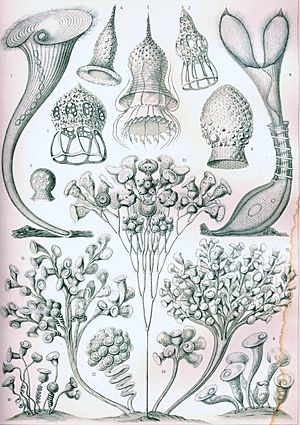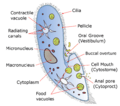Ciliate facts for kids
Quick facts for kids CiliatesTemporal range: Ediacaran - Recent
|
|
|---|---|
 |
|
| "Ciliata" from Ernst Haeckel's Kunstformen der Natur, 1904 | |
| Scientific classification | |
| Domain: | |
| Kingdom: | |
| Superphylum: | |
| Phylum: |
Ciliophora
Doflein, 1901 emend.
|
| Classes | |
|
Karyorelictea |
|
Ciliates are a special group of tiny living things called protists. They are known for having many small, hair-like parts called cilia. These cilia are like tiny oars that help ciliates move around.
Cilia are found on all ciliates, though some only have them during part of their life. They help these tiny creatures swim, crawl, attach to surfaces, eat, and even sense their surroundings.
Ciliates are an important group of protists. You can find them almost anywhere there is water. This includes lakes, ponds, oceans, rivers, and even in soil. Scientists have described about 3,500 different types of ciliates. However, there might be as many as 30,000 species in the world! Ciliates can be very small, about 10 micrometers wide. Some can even grow up to 4 mm long, which is big enough to see without a microscope. They are some of the most complex single-celled organisms.
How Ciliates Eat
Most ciliates are heterotrophs. This means they get their food by eating other smaller organisms. They often feed on tiny bacteria and algae. Ciliates use special cilia around their "mouth" area, called the oral groove, to sweep food in.
These special cilia include rows of tiny hairs called membranelles and a paroral membrane. They work together to guide food into the mouth opening. The food then moves into a part called the gullet. Here, the food forms a small bubble called a food vacuole. This vacuole acts like a tiny stomach, digesting the food.
Ciliates have many different ways of eating. Some ciliates do not have a mouth. They get their food by absorbing nutrients directly from their surroundings. Others are predators and hunt down other tiny protists, including other ciliates.
Ancient Ciliates
Ciliates have been around for a very long time. Until recently, the oldest known ciliate fossils were from the Ordovician Period. This period was about 485 to 443 million years ago.
However, in 2007, scientists found even older ciliate fossils. These fossils were from about 580 million years ago. They were found in the Ediacaran Period. This shows that ciliates are truly ancient creatures!
Images for kids
-
Diagram of the ciliate Paramecium
See also
 In Spanish: Ciliophora para niños
In Spanish: Ciliophora para niños




